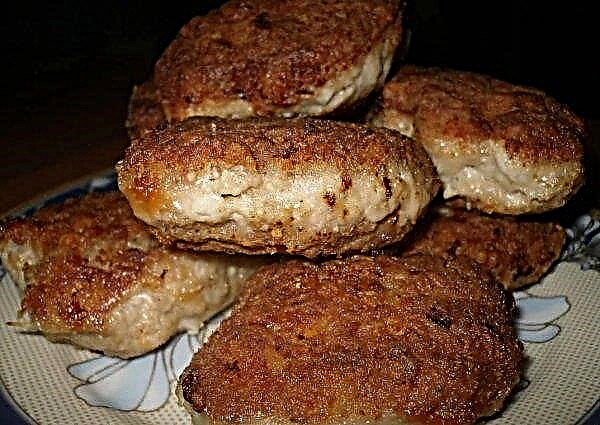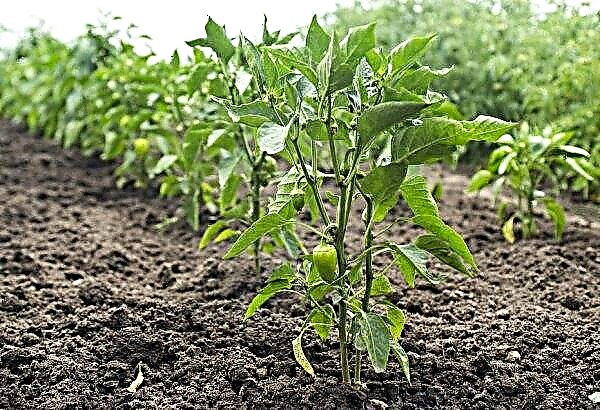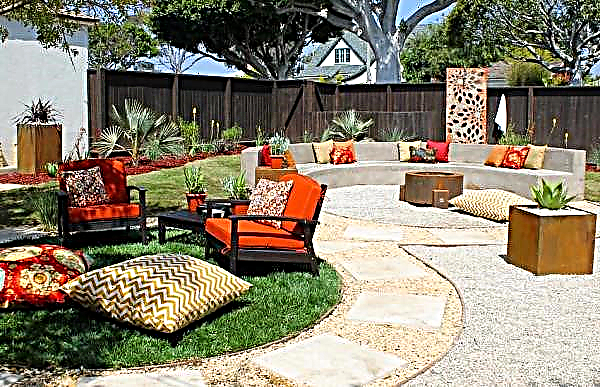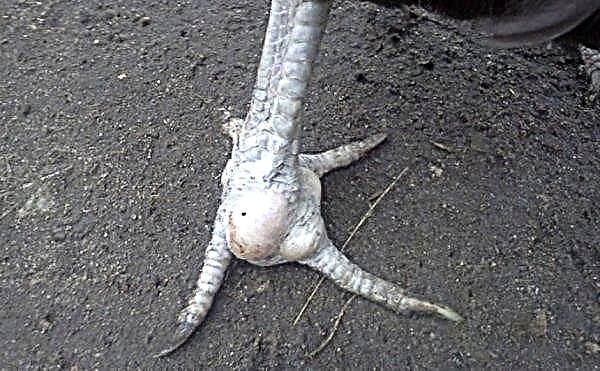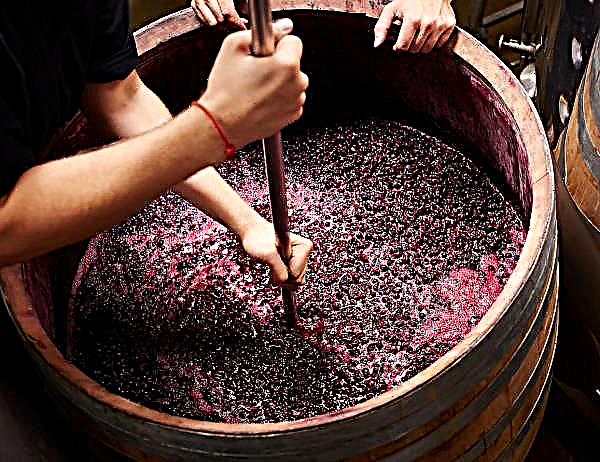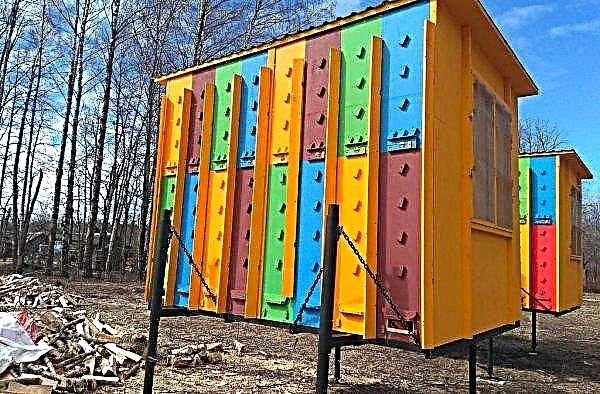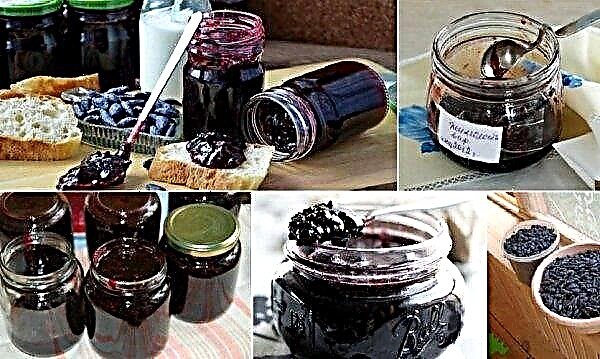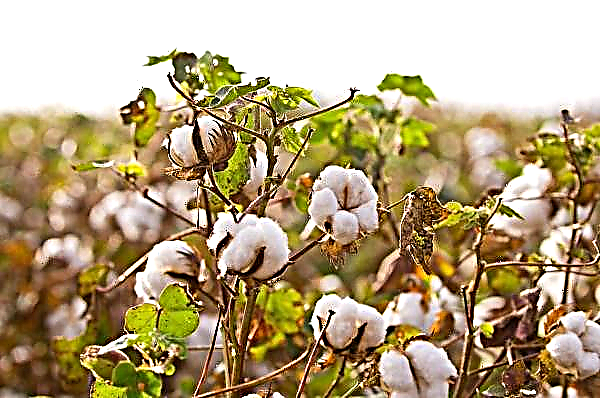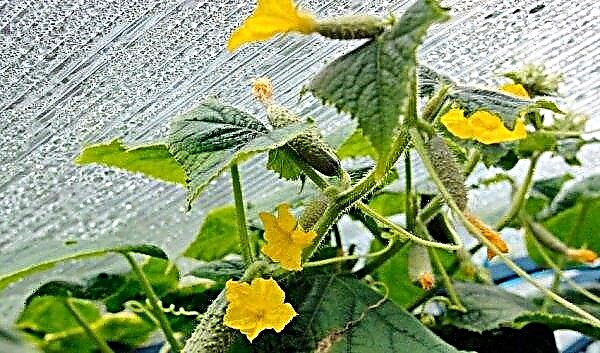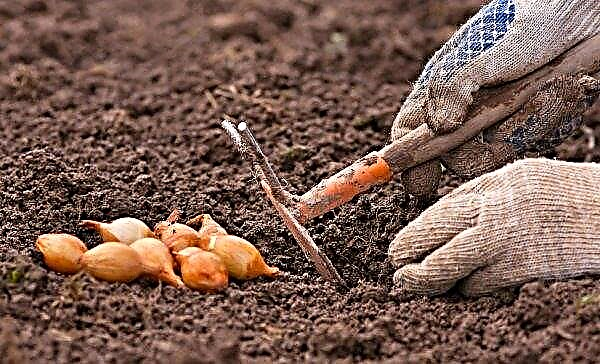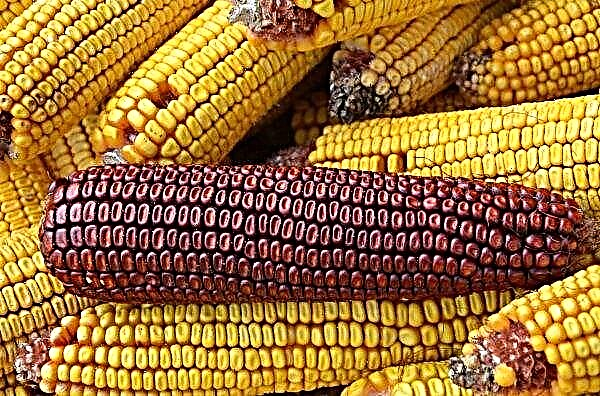Sensei tomatoes, contrary to the name, do not come from Japan at all, but from Siberia, where they manage to produce a powerful crop of delicious fruits in a short summer. In more comfortable conditions, their advantages only increase. About tomatoes of this variety, their features and growing technology will be discussed later.
Grade description
When breeding this variety, Novosibirsk breeders set the main task of the plant's ability to produce a good crop with high taste in a short growing season. And they did it.
Did you know? Only one large tomato is able to fill the daily requirement of the human body for vitamin C by 60%.
Sensei tomato variety is characterized by the following properties:
- being a determinant bush, in open ground rarely rises above a meter in height;
- ripening early, the fruits reach an average weight of 0.4 kg;
- has a high yield, giving from the bush up to 8 kg of fruit;
- ripe fruits acquire raspberry red color;
- fleshy, sweetish in taste and sugary pulp contains a small amount of seeds;
- rounded fruits are heart-shaped;
- the bushes have a moderate amount of green mass.

Advantages and disadvantages
- In addition to the listed qualities, the Sensei tomato variety also has the following advantages:
- stable immunity to common diseases of solanaceous crops;
- high taste and versatility in the use of fruits;
- ability to adapt to various temperature and humidity conditions;
- good transportability of the fruit;
- the ability of ripped green fruits to ripen successfully indoors.
A bright pronounced deficiency in this variety is not observed.
Vegetable growers note only the need to make additional efforts to:
- pinching and forming the optimal shape of the bushes;
- compliance with plant nutrition.
Self-growing seedlings
These tomatoes are grown exclusively by seedlings. Subject to the necessary conditions, seedlings are easy to grow on their own both from seeds obtained from the fruits of the previous harvest of this variety, and from purchased.
In the latter case, you can pass the stage of disinfection, which is carried out by specialists in the process of pre-sale preparation of seed material.
Optimum timing for sowing
Depending on regional climatic features, the sprouted Sensei seeds are sown in early or mid-March. A more accurate sowing period can be easily determined according to the rule according to which at least 60 days must pass from the moment of sowing the seeds to the planting of seedlings at a constant place of growth.
The soil
Soil prepared by professionals and sold in specialized retail outlets is optimal for obtaining good seedlings from seeds.
But you can prepare a completely decent soil with your own hands, mixing garden soil and humus in equal proportions and adding a little river sand, superphosphate and some potash fertilizers to this mixture or wood ash instead.
But before this, the earth should be decontaminated with a concentrated manganese solution and then calcined in an oven at a temperature of 190 °. A necessary condition is the stay after this disinfected soil in an open tank for at least 14 days.
Did you know? The first tomato variety that came from America to Europe was yellow. Today, in addition to becoming classic red, tomatoes have 6 colors. And they are multi-colored striped.
Capacity for growing
Almost any capacity up to 0.1 m high is suitable for growing seedlings. The main thing is that it be convenient when it is placed indoors and in service.
Most often for this purpose apply:
- plastic cups;
- peat pots;
- wooden boxes;
- plastic containers;
- peat tablets.
 The latter gained great popularity due to the ability to immediately combine the capacity and fertile soil in one peat washer, to which mineral fertilizers and growth stimulants were added. All that is required during planting is to place the tomato seed in a special recess in the upper part of the tablet.
The latter gained great popularity due to the ability to immediately combine the capacity and fertile soil in one peat washer, to which mineral fertilizers and growth stimulants were added. All that is required during planting is to place the tomato seed in a special recess in the upper part of the tablet.Seed preparation
As already mentioned, purchased seeds in undisturbed packaging do not require disinfection, which cannot be said about seeds obtained from fruits at home. They need to be placed for a third of an hour in a 1% solution of potassium permanganate. Then, for half a day, the seeds are aged in a growth stimulator.
In its absence, you can use fresh aloe juice, which also has a stimulating effect on tomato seeds. After that, the seed material at a constant temperature of +20 ° C is placed on gauze, regularly moistened by means of a spray.
Until the seeds are biting, they are hardened up to 5 times, placed in the refrigerator for 12 hours.
Sowing seeds
In the soil intended for sowing seeds, holes are made that stand no closer than 3 cm apart to a depth of 2 cm. Seeds of no more than two are placed in each of these recesses, covered with a small layer of earth, immediately moistened with spray gun.
Seedling Care
For better germination of sown seeds, it is necessary to create a greenhouse effect, which is formed using glass or a plastic film. They cover containers with sown soil and keep in this form at a stable temperature of +24 ° C.
When the seeds germinate, the coating is removed, and containers with seedlings are placed in a well-lit place at the same constant temperature. A couple of days after seedling emergence, it is required to be watered for the first time. And when 3 weeks have passed since the sprouts hatch, they need to be fed with bird droppings or fermented mullein. When the first two leaves appear on seedlings, it is dived into cups and a darkened place is placed, and when it gets stronger, it is returned back under intense light.
And when 3 weeks have passed since the sprouts hatch, they need to be fed with bird droppings or fermented mullein. When the first two leaves appear on seedlings, it is dived into cups and a darkened place is placed, and when it gets stronger, it is returned back under intense light.
5 days later after a pick, the sprouts are moderately watered with a small watering can with warm, settled water.
Seedling hardening
The appearance on the seedlings of the third leaf is a signal to the beginning of its hardening, which at a lower temperature starts from 5 minutes and then more and more lengthens. This procedure noticeably stimulates yield and strengthens the plant’s immune system. When a week remains before planting seedlings in open ground, the sprouts stop watering and lower the ambient temperature. And a couple of days before the transplant, the seedlings are left overnight in the fresh air.
Planting seedlings in a permanent place
Seedlings are planted in a permanent place when at least two months have passed since the day the seeds were sown. Do this with stably warmed air and earth and in the absence of the threat of frost. The beds for seedlings are prepared ahead of the fall, introducing humus and wood ash into the soil.
Best places for tomatoes are areas that were previously intended for growing:
- cabbage;
- cucumbers
- lettuce;
- beets;
- carrots;
- Luke;
- legumes;
- gourds.
 It is not recommended to use areas for tomato planting on which previously grew:
It is not recommended to use areas for tomato planting on which previously grew:- potatoes;
- eggplant;
- tobacco;
- Tomatoes
- pepper.
Important! Tomatoes not only can not be planted in the same place for the next year, this should not be done until 3 years have passed.
In addition, areas located on a hill and reliably protected from the winds should be reserved for tomato beds. The distance between tomato bushes is at least 45 cm.
The depth of the holes should be such that after placing in them an earthen coma with a root system, the soil poured on top reaches the cotyledon leaves. After planting, seedlings should be immediately poured with warm water.
Outdoor Care
Planted in a permanent place seedlings require subsequent painstaking and systematic care.
Watering
Sensei cultivars are content with moderate watering, which is best done in the mornings or evenings. In this case, you should not use tap water for irrigation from a hose, since cold water has a stressful effect on tomatoes.
Therefore, water is often used for irrigation, settled and heated in a barrel. The seedlings first planted in a permanent place are watered in a week. Until the plant blooms, it is watered after 3 days, pouring 3 liters of water under each bush. After the appearance of inflorescences and ovaries, the irrigation rate increases to 5 liters under each bush, but the frequency decreases to 1 time per week. Water is poured exclusively under the bush.
After the appearance of inflorescences and ovaries, the irrigation rate increases to 5 liters under each bush, but the frequency decreases to 1 time per week. Water is poured exclusively under the bush.
Important! During fruit formation, watering intensity should be reduced.
Fertilizer application
This tomato variety is very demanding on top dressing and is noticeably responsive to fertilizer application. Therefore, Sensei is repeatedly fed during the growing season, varying both the composition and fertilizers and the method of their application.
10 days after transplanting seedlings into open ground, it is fed for the first time with superphosphate and potassium sulfate, which are added to a bucket of water of 35 g each. With the help of phosphorus, the root system is strengthened, and potassium has a positive effect on the taste conditions of fruits.
The development of green mass is well influenced by nitrogen, which is abundant in organic fertilizers.
When the plant blooms, it is sprayed with a solution of boric acid, which is prepared by adding 10 g of the drug to a bucket of water. This operation prevents the falling of inflorescences and activates the appearance of ovaries.
During the period of growth and ripening of the fruit, excess nitrogen only prevents this process, therefore, organic fertilizing must be stopped and emphasis should be placed on fertilizers that have in their composition:
- potassium;
- phosphorus;
- iodine.
Useful in this regard is a folk remedy in the form of wood ash, which is saturated with potassium, magnesium, calcium and other minerals, so popular tomatoes.
Stepson
In this tomato variety in deciduous sinuses, stepsons are quite actively formed, which create excess green mass, which takes away from the plant the nutrients necessary for the formation and growth of the fruits. Therefore, starting in July and every 10 days, stepsoning is performed.
Foliage is completely removed from the lower tier, and, if necessary, partially from other tiers. Green mass should not impede the access of sunlight to the fruit. Stepsons break off with fingers disinfected with a weak manganese solution. Specialists do not recommend using scissors for herding.
Soil care
Sensei tomato responds well not only to top dressing, but also to loosening the soil above its roots. This procedure is recommended to be carried out every time after watering, but at least once every half a month. In parallel with loosening, weeding is also carried out.
During loosening, so as not to harm the root system, during the first month of plant growth in open ground, it is necessary to go deeper into the soil by no more than 12 cm, and after that this depth decreases to 8 cm.
In order to create optimum temperature and humidity conditions in the root system of tomatoes, it is also necessary to cultivate bushes with moist soil or to replace this process with mulching of root soil with humus.
Tying bushes
Sensei cultivars have one or two powerful stems, which at a relatively low height and moderate density of green mass at first often do without garter. However, when the fruits ripen, which weigh on average up to 0.4 kg each and which in the hands there are up to 5 pieces, you have to resort to tying with the help of stakes or trellises driven in next to the bushes.
However, when the fruits ripen, which weigh on average up to 0.4 kg each and which in the hands there are up to 5 pieces, you have to resort to tying with the help of stakes or trellises driven in next to the bushes.
The branches are tied with tassels hung with tomatoes by means of cords with a low coefficient of rigidity, so that the fruits have better access to sunlight, and the fruits themselves do not come into contact with the soil and do not become infected by infection.
Preventative treatment
Sensei tomatoes are resistant to:
- tobacco mosaic;
- alternariosis;
- late blight;
- vertically withering;
- Fusarium
That is, to all those diseases that most often affect nightshade crops. Successfully repels Sensei and pest attacks. However, this does not mean at all that these tomatoes are completely protected from diseases and pests.
Therefore, plants require the preventive help of a person in order not to be invaded, for example, by aphids, Colorado potato beetles or spider mites.
For this, the grower needs:
- Inspect the leaves at least once a week from the back.
- Regularly weed weeds.
- When volatile pests appear, spray the bushes with insecticides.
- Spray plants with antifungal biological agents.
- If slugs are found, immediately collect them with your hands and treat the bush with ammonia dissolved in water.

Harvesting
The fruits are covered with dense skin, and during their collection, as well as during transportation, no problems arise. This contributes to their good keeping quality. In addition, Sensei has remarkable quality, which is almost indispensable in regions with a short summer.
They, being ripped off at the very end of the warm period in green form, are perfectly stored in a warm, dry and darkened place. And if they are placed in a lighted place at home, they will quickly turn red and become salable.
This Siberian variety with a Japanese name has been certified relatively recently, but with its outstanding qualities it has already gained fame among amateur vegetable growers who pay tribute to the taste qualities of Sensei fruits and its ability to take root in a variety of climatic conditions.

